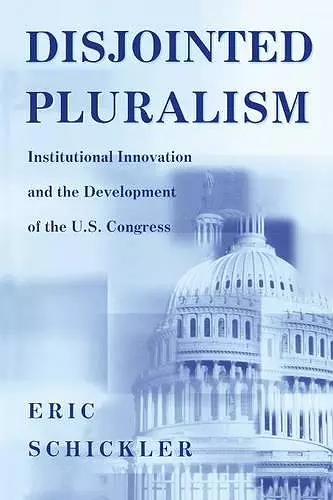Disjointed Pluralism
Institutional Innovation and the Development of the U.S. Congress
Format:Paperback
Publisher:Princeton University Press
Published:16th May '01
Currently unavailable, and unfortunately no date known when it will be back

This is an excellent piece of work, which will be influential. Both rational choice and developmental theorists and congressional scholars will read it. This book will be required reading for all Americanists in political science. It should win several prizes for its thoughtfulness, appropriateness, and careful, knowledgeable use of history. -- David Brady, Stanford University This is an ambitious piece of work on an important topic. I am impressed with the exhaustive search for sources and the splendid, integrated account of so much of Congress's institutional development. It is a remarkable achievement. -- Steven S. Smith, University of Minnesota
Analyzing leadership, committee, and procedural restructuring in four periods, this book argues that coalitions promoting a wide range of member interests drive change in both the House and Senate. It shows that multiple interests determine institutional innovation within a period; and that different interests are important in different periods.From the 1910 overthrow of "Czar" Joseph Cannon to the reforms enacted when Republicans took over the House in 1995, institutional change within the U.S. Congress has been both a product and a shaper of congressional politics. For several decades, scholars have explained this process in terms of a particular collective interest shared by members, be it partisanship, reelection worries, or policy motivations. Eric Schickler makes the case that it is actually interplay among multiple interests that determines institutional change. In the process, he explains how congressional institutions have proved remarkably adaptable and yet consistently frustrating for members and outside observers alike. Analyzing leadership, committee, and procedural restructuring in four periods (1890-1910, 1919-1932, 1937-1952, and 1970-1989), Schickler argues that coalitions promoting a wide range of member interests drive change in both the House and Senate. He shows that multiple interests determine institutional innovation within a period; that different interests are important in different periods; and, more broadly, that changes in the salient collective interests across time do not follow a simple logical or developmental sequence. Institutional development appears disjointed, as new arrangements are layered on preexisting structures intended to serve competing interests. An epilogue assesses the rise and fall of Newt Gingrich in light of these findings. Schickler's model of "disjointed pluralism" integrates rational choice theory with historical institutionalist approaches. It both complicates and advances efforts at theoretical synthesis by proposing a fuller, more nuanced understanding of institutional innovation--and thus of American political development and history.
Winner of the Fenno Prize "This is a very good read for students of Congress who puzzle over the institution's configuration... An excellent examination of institutional change."--Choice "If we know anything about the U.S. Congress it is this: Congress is a dynamic, ever-changing institution... Alas, for good reasons our theories of congressional organization tend to the static and our empirical analyses tend to the cross-sectional. Eric Schickler's fine book joins a growing set of efforts to understand how and why Congress changes."--Garry Young, Political Science Quarterly "This book is essential reading for those interested in internal legislative politics, and an important contribution to the more general literature on American politics."--Keith E. Whittington, Congress and the Presidency
- Winner of American Political Science Association: Richard F. Fenno Prize 2002
ISBN: 9780691049267
Dimensions: unknown
Weight: 567g
376 pages